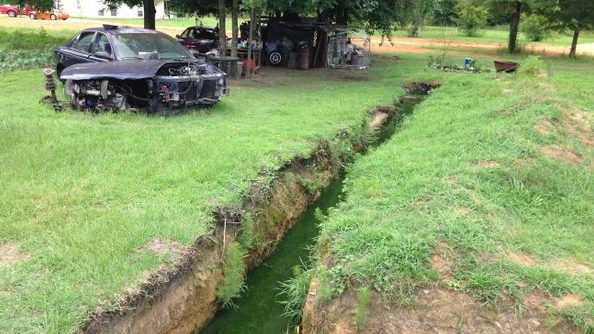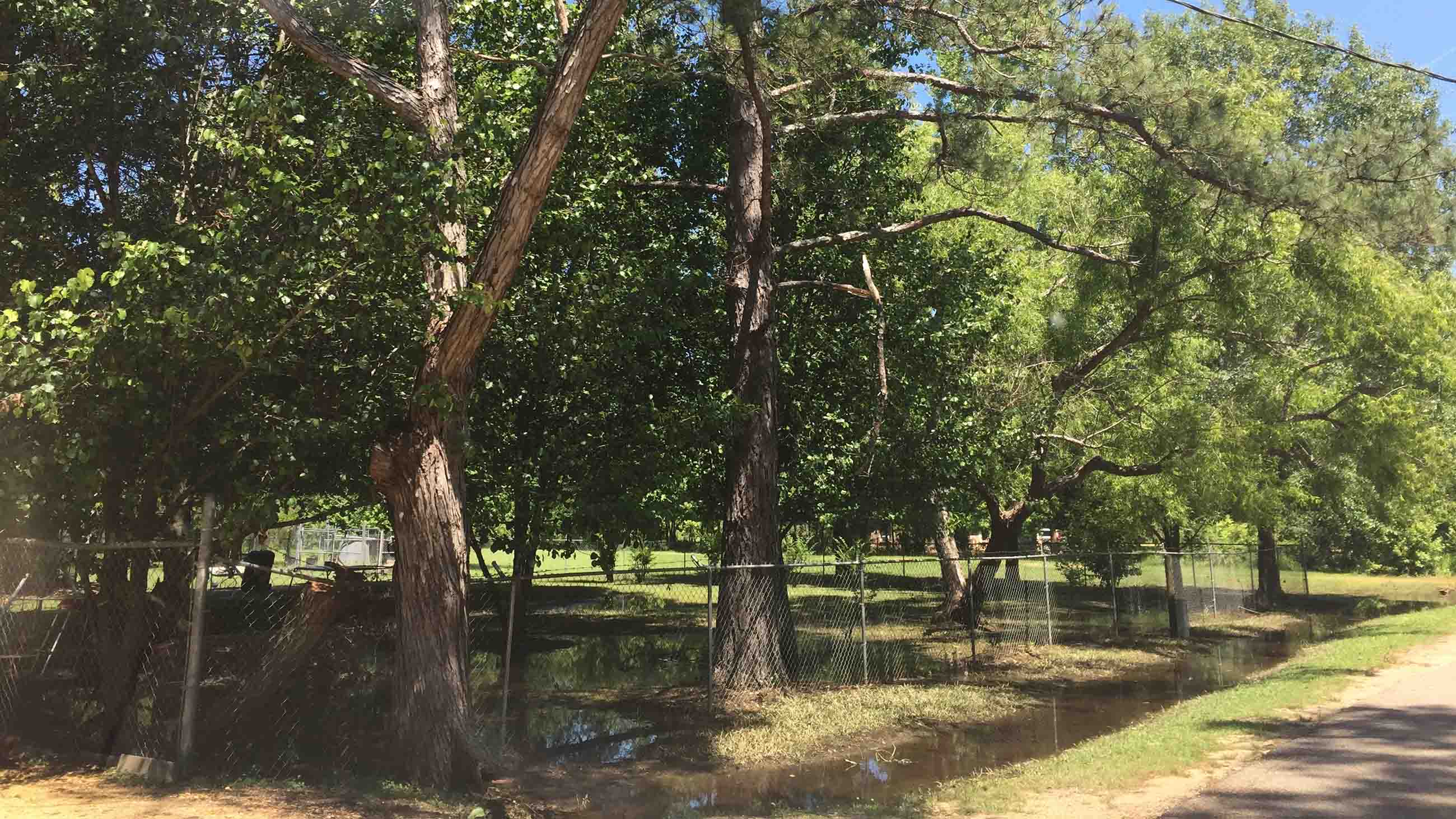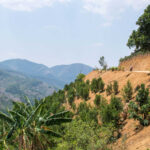In the American South, an Inequity of Diseases
On a muggy day in October 2009, Catherine Flowers stepped down the stairs behind a mobile home in Lowndes County, Alabama to find a pit filled with raw sewage. Mosquitoes and flies buzzed around, and a putrid smell hung in the damp air. Without any municipal sewer treatment or an onsite septic system, the owner of that mobile home had little choice but to pump waste outside. It had rained more than usual that month, so the pit overflowed. The sewage leaked through the yard and seeped into the soil.
As Flowers, the founder of the nonprofit Alabama Center for Rural Enterprise, examined the scene, several mosquitoes bit her legs. Three days later, she broke out in an expansive red and blotchy rash. Doctors ran tests for bacterial infections and allergic reactions, and gave her creams for the itch. But the tests came back negative and the creams didn’t work. After three months, the rash eventually faded away.
Flowers asked her doctor if perhaps the tests hadn’t focused on the right kind of infection, since the third-world conditions of the mobile home were unexpected in the United States. The doctor said it was possible.
Eight years later, on a stifling hot spring morning, the 58-year-old Flowers, who also works on race and poverty initiatives at the Equal Justice Initiative and is an avid environmental justice activist, drove through Lowndes on the famous 54-mile highway between Selma and Montgomery that Martin Luther King Jr. and hundreds of others marched in 1965. “This road is supposed to represent equality in the United States,” she said. “But here, there’s one of the most glaring forms of inequality in the U.S.”
For decades, this poor, rural county has lacked basic wastewater infrastructure. With climate change driving warmer temperatures and heavier rains, flooding is more common, and the standing water and raw sewage attracts mosquitoes and other tropical disease vectors. Flowers has witnessed these conditions since her childhood — she grew up in the area — and long suspected they were a problem. But earlier this year, her suspicions were confirmed: researchers from the National School of Tropical Medicine at Baylor College of Medicine in Houston, Texas, found tropical parasites in Lowndes County that are typically found in developing countries.
“This is the frontline community for environmental injustice, already suffering from climate change and having health issues exacerbated by it,” Flowers said. “We’re starting to see the possibility of tropical illnesses in places that didn’t have them before. And we don’t have infrastructure in place to address it, nor are our medical personnel being trained to find it.”

The dense forests in rural southern Alabama are lush and green in the late spring. Spanish moss hangs heavy from oak and cypress trees along the Alabama River in Lowndes County, which has a dwindling population of about 11,000. Most live in narrow ranch-style houses or mobile homes along the back roads off Interstate 65, which connect the three largest towns: Fort Deposit, which is the most populous; Hayneville, the county seat; and White Hall, where Flowers grew up. Here in the heart of the Black Belt, the county is 73 percent black. A tall Confederate monument memorializing fallen soldiers sits prominently in the middle of the small Hayneville town square.
During a visit in late May, Flowers surveyed Fort Deposit, Hayneville, and White Hall. There was standing water everywhere — in yards, along gravel side roads, in ditches and fields — even though it was 90 degrees and hadn’t rained for several days. A man stood ankle deep in a puddle and scooped out water from his yard with a plastic bottle. Across the street, a woman’s yard was completely flooded — a Hayneville wastewater lagoon recently overflowed, as it often does when it rains. Flowers pointed out dozens of homes that dump raw sewage in their yards because they can’t afford individual septic systems. Many of these families participated in the Baylor College of Medicine study.
Flowers has a commanding presence and contagious laugh, and she never meets a stranger — especially in Lowndes County. She was born in Birmingham, but her family moved to Lowndes in the 1960s, at the height of the Civil Rights Movement — when it was called “Bloody Lowndes” for the excessive police violence against black residents. The family used an outhouse for years before her parents installed an onsite septic system. But the dark, rich Alabama soil, perfect for agriculture, retains water, so the systems overflow in hard rains.
After a couple of decades teaching around the country, Flowers returned to Alabama in 2000. She first worked in economic development, and then homed in on water infrastructure and public health. In outlining a project in 2005 aimed at improving wastewater management, Flowers pointed out that only 18 percent of Lowndes residents were on municipal sewer systems. About 82 percent would have to rely on onsite wastewater systems that ran between $5,000 and $30,000 — money most people didn’t have. In the early 1990s, Flowers said, the health department cited residents who didn’t have onsite septic systems; in some cases, the citations led to police arrests. With the help of the Woodson Center, a nonprofit in Washington, D.C. that supports low-income communities, she helped stop the arrests.
Also in the early 1990s, a University of Alabama study on a small clinic in neighboring Wilcox County revealed that a third of children under age 10 had intestinal helminths, parasites linked to poor sanitation and contaminated soil. By the time Flowers was bitten by those mosquitoes in 2009, she had a feeling the effects of climate change were making conditions in rural Alabama worse. Three years later, she read an op-ed on tropical diseases as the new plague of poverty in The New York Times, written by Peter Hotez, a pediatrician and dean of the National School of Tropical Medicine at Baylor. It sounded all-too familiar. “I held onto that article, kept going back to it,” she said. Three months later, she emailed Hotez and told him about Lowndes.
Hotez is one of the world’s leading experts on neglected tropical diseases, and helped found the National School of Tropical Medicine six years ago. He said these types of neglected diseases, which most people associate with developing nations, impact 12 million people living in poverty in the U.S. already, and more are at risk. Most are on the Gulf Coast in Texas and in the Southeast. Poverty is the overriding determinant, but other key factors include hot and wet conditions, climate change, migration, and increasing numbers of vector species. “These diseases are not on anybody’s radar,” Hotez said. “They’re occurring in flyover country, among the poor, in neighborhoods that go unseen.”


There’s West Nile virus, mostly spread by Culex mosquitoes in economically depressed areas like rural Alabama, Mississippi, Louisiana, and southeast Texas — usually where there are unsanitary conditions, which attracts the mosquitoes, and standing water, where they like to breed. Zika virus is spread by Aedes mosquitoes in tropical conditions and places that are environmentally degraded, Hotez said, like run-down homes and yards filled with trash. Then there is Chagas disease, which, if left untreated, leads to congestive heart failure. Although Chagas is most common in Latin America, it’s now also found in the southern U.S. and Texas. The disease spreads through “kissing bugs,” which live in lush vegetation and trees. The bugs are often found in rural areas where people are easily accessible — like mobile home parks.
Other poverty neglected diseases in the South — particularly low-income areas along the Gulf Coast and Texas — include cysticercosis, a tapeworm transmitted through human feces, and murine typhus, a bacterial infection spread by fleas.
For more than two decades, Hotez has tried to convince governments, doctors, and communities to take direct action, with little avail. “We’re not going into communities we think are affected and doing active surveillance and testing,” he said. “We’re not doing anything to look at how they’re being transmitted in America. We are not providing access to diagnosis and treatment, and we’re not doing research and development except [at the National School of Tropical Medicine.]”
After Flowers told Hotez about the conditions in Lowndes in 2012, a team from the school decided to survey the area for signs of similar types of tropical parasites. Over the next couple of years, Flowers and scientists including Hotez and Rojelio Mejia, also at the National School of Tropical Medicine, took dozens of samples of feces, water, soil, and blood from people throughout the 720-square-mile county. The researchers won’t cite specifics because they aren’t publishing the study until later this summer after peer-review, but Hotez said they found evidence of tropical parasites that are common in sub-Saharan Africa, Southeast Asia, and Latin America.
Dawn Wesson, an associate professor of tropical medicine at Tulane University who was not involved with the study, said that there are several reasons these parasites could be showing up more frequently in areas like Lowndes County: an increase in detection, awareness, and the discovery of rare parasites that are endemic to the U.S., but rarely show up in humans. “Human exposure can increase in poor housing conditions,” Wesson said. Exacerbating the spread of tropical diseases, she said, are climate change and travel.
When the researchers were out testing, one of them shared photos of the raw sewage in the Lowndes yards with colleagues around the world. Flowers recalled some of them saying they “couldn’t believe this was in America.”
In Lowndes County, Alabama, lack of sewage infrastructure leaves residents vulnerable to disease.
The Southeastern U.S. is exceptionally vulnerable to sea level rise, extreme heat waves, hurricanes, and water scarcity. Temperatures have increased an average of two degrees Fahrenheit since 1970, with higher jumps during the summer. That means mosquito season will only get longer, Wesson said. “In the South, we have longer transmission seasons and we can expect those to become even longer. Right now, it’s May through September, but it might be March through October.”
With more frequent and intense weather events — like hurricanes, tornadoes, and flooding — more people are exposed to pathogens than normal. For instance, a West Nile virus outbreak followed Hurricane Katrina. “When people are driven out of their homes, or exposed when they’re trying to clean up disaster areas and get back in, or protect their homes, those types of situations increase the chances for transmission of these diseases,” Wesson said.
As sea levels continue to rise, more people will move inland to both rural and urban areas. According to a 2015 analysis by Climate Central, by the end of the century, nearly 33,000 people are at risk of up to 10-foot flooding in Alabama alone. Within the last few years, Flowers traveled around the country to conferences to speak about the lack of water infrastructure, tropical diseases, and climate change in rural areas. She’s also helping Hotez and a few senators introduce a bill called “Eliminating Neglected Infections of the Poorest Americans Act.” And Flowers recently submitted recommendations to the Environmental Protection Agency for improvements in Lowndes, including a five-mile extension of the municipal water system in Fort Deposit; getting rid of the wastewater lagoon; and funding research for wastewater technologies.
One of the best ways to protect people is education, Wesson said. That means communicating the risks as well as the importance of preventative techniques like putting up proper window screens, cleaning up yards, and using bug spray when outdoors. But that education only goes so far when there’s raw sewage on the ground.
Near the end of her visit to Lowndes in May, Flowers took a break at the Selma to Montgomery Trail exhibit at the Lowndes County Interpretive Center. She paused often, silently reading quotes about equality from movement leaders, as she had done dozens of times before. Lowndes is her home, and seeing the conditions unchanged for decades hurts — she wants to come back here to live. “I’ve been offered other jobs, and there are other things I want to tackle,” she said. “But I want to see this through first. I don’t know if it will get done if I don’t do it.”
Lyndsey Gilpin is a journalist based in Louisville, Kentucky. Her work has appeared in High Country News, FiveThirtyEight, The Atlantic, Outside, Hakai, The Washington Post, and more. She is the editor of Southerly, a weekly newsletter about the American South.











Comments are automatically closed one year after article publication. Archived comments are below.
Why did people stop using outhouses? If water supplies or treatment options aren’t available, composting privies are also possible: http://humanurehandbook.com/manual.html
Muriel, the toilet types that you list (outhouses and composting privies) are actually feasible technical solutions to the problem (with a couple minor caveats). However, they are not desirable or even acceptable to the vast majority of the population. For outhouses (1) no one wants to go outside to use the bathroom and (2) outhouses are seen as technology for either the impoverished or for the 19th century. As for composting toilets, nearly everyone wants to “flush and forget.” It is a small percentage of the population that are willing to either handle or compost their feces.
If affordable alternatives to the flush toilet are to address this problem, they will need to be seen as aspirational and/or yield adequate economic or social benefits to be widely accepted. I have heard the comment in rural Alabama that composting toilets “aren’t much better than an outhouse.” Among environmentalists, composting toilets are seen as aspirational and yield increased social status in that subculture. At this point that is simply not true among most Americans.